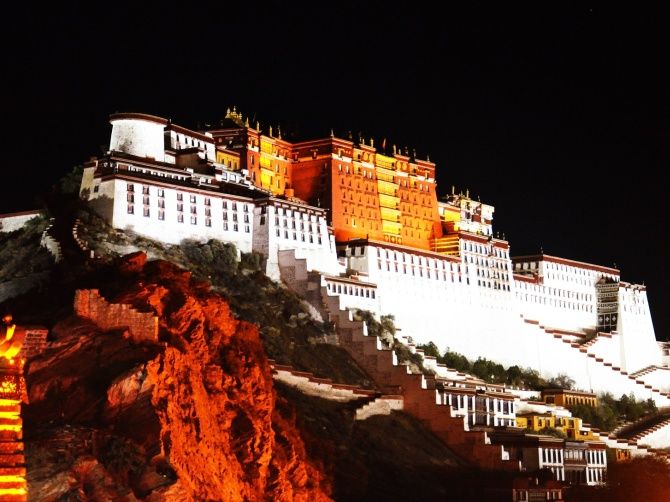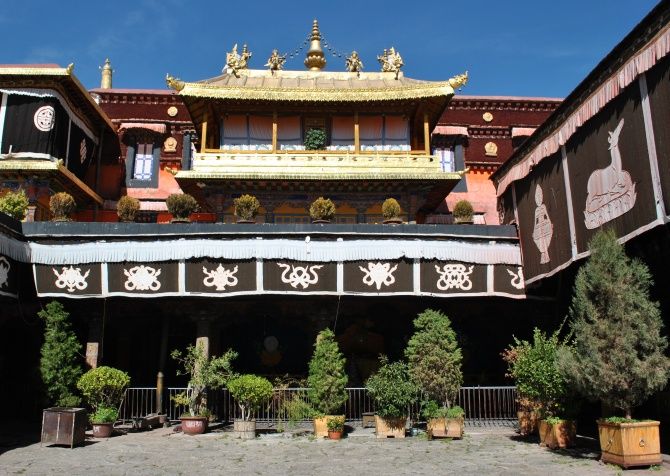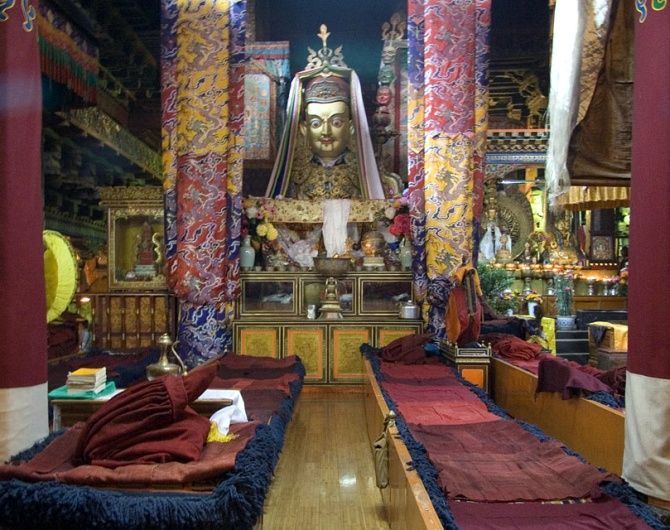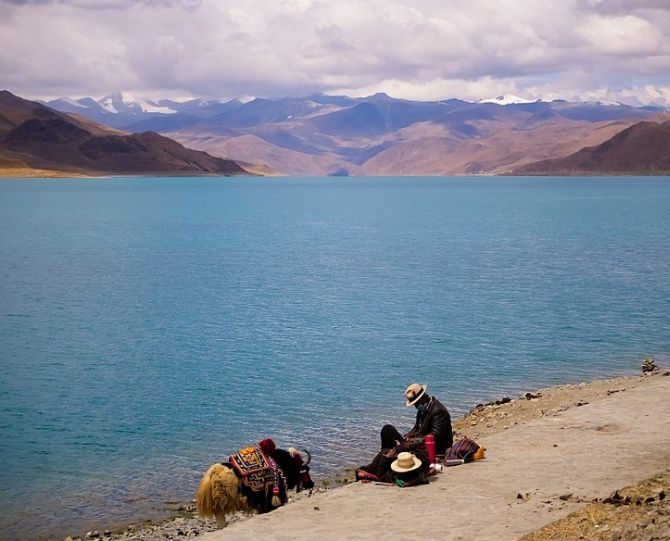'Lhasa is more than the Unesco World Heritage Sites it boasts of. It is more than a gateway to the mighty Himalayas.'
'It is about the warmth of its people: Unsaid, unspoken, but felt everywhere,' discovers Shruti Bajpai.

The train pulls out of Xining station, one carriage at a time. The railway platform is empty except for a lone guard waving his green flag.
My train carriage also falls silent, as if in anticipation of the journey that lies ahead.
This is no ordinary train ride, after all: This is the Xining-Lhasa railway journey in China, the highest railway system in the world, 1,956 km of breathtaking landscape that forms the Qinghai-Tibetan plateau.
The construction of this railway line is as much a marvel as the panoramic landscape it is built on.
Built above 500 km of permafrost -- soil that remains permanently frozen, making railroad construction difficult -- the railway system made use of bridges to circumvent especially difficult permafrost patches, stone embankments and underground pipe vents to circulate air and keep the soil ambient.
The next 22 hours pass slowly as I begin my ascent from Xining station.

The journey starts from an elevation of approximately 7,500 feet above sea level at Xining and slowly inches up to an astounding 16,000 feet at the Tangula Pass and Andou, which is the world's highest railway station, before culminating in Lhasa at a height of 12,000 feet.
I am in no hurry. I want to savour every moment of this voyage to the roof of the world.
The canvas before me is a veritable time lapse of barren plateau, lush green hills and winding rivers, dotted by yaks and mountain goats. I feel meek and humble against nature's seemingly infinite expanse.
The next day, the warm glow of the morning sun streams though the window and lights up the otherwise drab sleeper berth cabin.
I am now officially in 'Xi Zhang' (Xi is 'west' and Zhang is 'land' in Chinese) the Tibet Autonomous Region, China, approaching the last stop in this remarkable railway journey.
The terrain hasn't changed much, but I now start to spot civilisation -- an occasional shepherd, brightly painted houses and the omnipresent prayer flags that signal my arrival in Lhasa.
Just outside the railway station, an imposing monument to the People's Republic of China's chairmen, past and present, greets me. Their smiling faces seem to follow me everywhere I travel in Lhasa.

Lhasa stands out from the other cities that I have visited in and around China.
Despite the new roads and towering bridges, products of the astounding pace at which China is developing and urbanising every nook of the country, the city has managed to retain its earthiness.
I walk around Barkhor Street, the central hub of the city. There are shops selling everything from kitschy souvenirs to fine hand-painted Thangkas (Tibetan wall hangings), incense sticks, exotic Tibetan jewellery and woollen shawls.
Within a few hours of my arrival, though, I feel an inexplicable air of melancholy hanging over the city.
An old woman walks by, prayer wheel in one hand and a string of beads in another, completing her kora, the holy circumambulation around the city.
To most Tibetans, the kora is a daily practice, one that keeps them centred.

I begin my discovery of Lhasa with a visit to the Norbulingka Palace, the summer palace of successive Dalai Lamas.
Built in 1755 by the seventh Dalai Lama, this Unesco World Heritage Site runs over acres of beautifully landscaped gardens and buildings.
I spend an entire day walking in and out of the garden paths, the maze of courtyards and the palace rooms.
A Han Chinese couple stands nearby, decked up in traditional Tibetan wedding finery, posing for wedding pictures.
The deep ochre and mustard-coloured ramparts serve as a natural backdrop to their photo-shoot.
My next stop is the Sera Monastery, one of Lhasa's two famous monasteries (Deprung is the other), which houses libraries and assembly halls for resident monks.
Built in 1419, the monastery is most famous for its debating sessions, where the monks, dressed in deep red robes, assemble every day in the main courtyard, under a bright orange canopy, to test each other's knowledge of Buddhist scriptures.
The tourist in me gawks at the noisy exchange of points and counter-points; a clap of the hand, exaggerated expressions and a rapid-fire round of questions and answers are the key components of these debates.
The vibration of the frequent clapping rings loud in my ears even as I make my way out of the monastery.

The following day I rise early to walk up to the Potala Palace, once a seat of power, now a museum.
The palace is yet another Unesco heritage site in Lhasa and perhaps the most significant one.
This majestic white and red structure, flanked by mountains on either side, looms large over Lhasa city, the stories of its volatile past ensconced forever within its walls.

First built as a fort in 637 by Songtsen Gampo, founder of the Tibetan empire, it was made the official palace of the Dalai Lama in the 18th century.
The number of visitors to this palace is limited to 2,500 a day to control the surge of humanity inside the ramparts and to protect the building.
Inside the palace are rooms full of magnificent Buddha and Bodhisattva statues, as well as shrines and tombs of earlier Dalai Lamas, each more exquisite than the next.

The last World Heritage Site on my itinerary is the Jokhang Temple, the most revered temple in all of Tibet.
The temple was built in the 7th century by Songtsen Gampo for his two brides, Princess Wencheng from China and Princess Bhrikuti from Nepal, who brought with them Buddhist idols and treasures.
The gold temple domes glisten in the bright sunlight. Various statues of the Buddha and the three Bodhisattvas -- Avalokiteswara (the Bodhisattva of Compassion), Manjusri (Wisdom) and Vajrapani (Energy) -- gaze at me as I move into the inner sanctorum of the temple.
My final day in Lhasa is marked by a drive through the Sino-Nepal Friendship Highway, to the Kambala Pass at nearly 16,000 feet.

The mighty Yarlung Tsampo, which becomes the Brahmaputra in India, flows quietly alongside.
On my way up, I notice a string of stone-piles lining each hairpin bend. I later learn that these are makeshift stupas that serve as humble offerings made by devout passersby.
Then, all of a sudden, the majestic Yamdrok Lake appears as if from nowhere. It almost feels like a mirage -- unspoiled and flawless in one of God's own countries.

The deep hues of turquoise, azure and aquamarine shimmer in the soft afternoon sunlight.
Quick glimpses of the past week in Tibet flash through my mind.
The rich colours of the Norbulingka summer palace, the imposing façade of the Potala Palace, the deep devotion that envelopes the Jokhang temple, the riot of colour and dialogue in Sera monastery and the dazzling pristineness of Yamdrok Lake.
But it's the sadness in the eyes of the devotees performing the kora on Barkhor Street, the longing in the smiles of the women selling yoghurt atop the Potala Palace, the hope in the eyes of the children playing alongside the Jokhang Temple that will haunt me forever.
Lhasa is more than the Unesco World Heritage Sites it boasts of. It is more than a gateway to the mighty Himalayas.
It is about the warmth of its people: Unsaid, unspoken, but felt everywhere.











